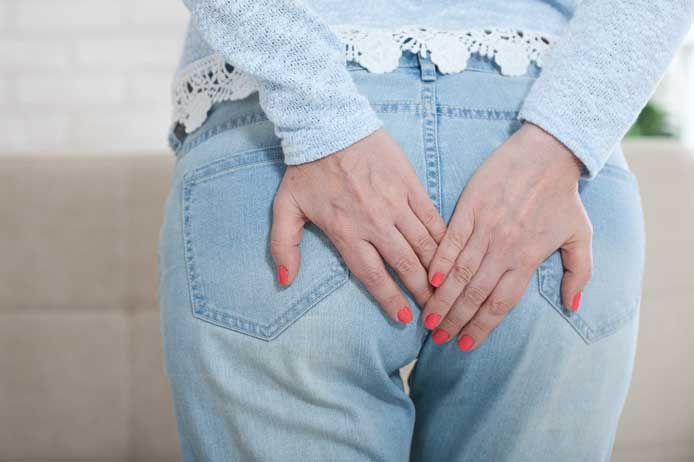
Haemorrhoids: No taboo!
Always feared and for a long time labelled as a taboo subject: morbhoids. With the wrong lifestyle, these small vessels can become troublesome and severely affect our daily lives. When complaints arise, many people resist going to the doctor because they are ashamed. But why is that? Here you can find out what morrhoids are and why they should not be a taboo subject.
What they are and why they should not be a taboo subject.
What are mucous membranes?
If the question arises whether someone has morrhoids, the answer must always be the same: Yes! Because even though the term has a negative connotation, everyone has haemorrhoids. They are located on the sphincter muscle on the outer part of the rectum and are nothing more than blood-flowing vessels. Together with the sphincter muscle, they form natural sealing tools that close the anal canal and thus ensure dry underwaters.
The way they work is quite simple: when you go to the toilet, the sphincter muscle relaxes and the blood in the rectum flows out. This clears the way for the stool. After the operation, the sphincter muscle is activated again, the morrhoids fill with blood again and block the anal canal. In this way, they serve as flexible gavels and prevent the unwanted leakage of excretions.
So far, so good.
However, if the haemorrhoids increase in size, they can become troublesome. In medicine, this is also known as haemorrhoidal disease. This is an approximate diagnosis, but it can be unpleasant and usually requires medical advice. The causes can be as varied as the treatment options themselves.
How does a condition develop?
Hämorrhoidal disease is usually caused by excessive pressure in the body and is particularly widespread in the western world. Sitting down for long periods of time during working hours greatly increases the incidence of enlarged mucous membranes. But long hours of work are not the only typical risk factors.
Other causes of haemorrhoidal disease:
- Vigorous pressing during bowel movements, e.g. in the case of constipation
- regular lifting of heavy objects
- lack of exercise
- Pregnancy
- &Overweight
A diet low in dietary fibres is also a perfect target for haemorrhoidal disease. So if you eat mainly highly processed foods and avoid fibre-rich foods, you may be susceptible to enlarged mucous membranes.
When you eat a low-fibre diet, you may be susceptible to enlarged mucous membranes.
When the butt burns: typical symptoms
Itching or burning at the anus can be the first sign of enlarged haemorrhoids. However, many people underestimate these signals because they are only noticed occasionally or are perceived as normal. Only when there are visible indications do they usually know for sure that they have a condition. Typical examples are palpable deformations at the anus, stool traces in the underwear or blood in the stool and on the toilet paper. Then, at the latest, it is high time for a visit to the doctor, which cannot be postponed, because the longer it is prolonged, the more unpleasant the symptoms can become.
Treatment for haemorrhoids
Once you have decided to see a doctor, the first step is a consultation. This is followed by a physical examination to determine the degree of the condition. Here, a distinction is made between grade 1 (mild hemorrhoidal disease) and grade 4 (severe hemorrhoidal disease). The treatment options vary depending on the degree of severity.
First- and second-degree morrhoids are usually treated with what is known as sclerotherapy in which the morrhoids are sclerosed . Alternatively, they can also be transferred or snipped off off. In the case of a tourniquet, rubber bands are inserted, which can cause enlarged mucous membranes to fall off after just a few days.
While conservative therapies promise improvement in the case of 1st and 2nd-degree haemorrhoids, minor surgical interventions are usually necessary in the case of 3rd or 4th-degree haemorrhoids. Here, too, there are different modern procedures. They make the removal of enlarged haemorrhoids gentle and as comfortable as possible.
4 Tipps zur Vorbeugung von Hämorrhoiden
Schätzungen zufolge leidet ungefähr jeder zweite Mensch im Laufe seines Lebens mindestens einmal an vergrößerten Hämorrhoiden. Mit diesen Tipps können Sie das Risiko eines Hämorrhoidalleidens jedoch deutlich verringern.
- Ballaststoffreiche Ernährung und viel Bewegung
Da Hämorrhoidalleiden oftmals durch Druck entstehen, sollten Sie am besten für einen weichen Stuhlgang sorgen. Mit ballaststoffreicher Ernährung und viel Bewegung können Sie Verstopfungen entgegenwirken. Vermeiden Sie zudem mehrminütiges Pressen während des Stuhlgangs. Nutzen Sie beim Toilettenbesuch auf alle Fälle einen kleinen Hocker und positionieren Sie sich so, dass Sie so wenig Druck wie möglich ausüben müssen.
- Regelmäßiges Aufstehen
Sitzen Sie hauptsächlich während der Arbeit? Dann bauen Sie feste Zeiten in Ihren Arbeitsalltag ein, in denen Sie aufstehen und sich von Ihrem Bürostuhl wegbewegen. Ist dies nicht möglich, gibt es mittlerweile auch spezielle Sitzkissen, die Ihrem Gesäß den Druck nehmen.
- Das Gewicht immer im Blick
Durch Übergewicht entsteht meist Druck auf den Enddarm. Ernähren Sie sich also gesund und treiben Sie ausreichend Sport. So lassen sich nicht nur Hämorrhoidalleiden vorbeugen, auch alle anderen Blutgefäße im Körper werden es Ihnen danken. Wie Sie gesunde Nahrungsmittel sogar auf der eigenen Fensterbank ziehen können, erfahren Sie in unserem Artikel Superfood.
- Tadellose Hygiene
Setzen Sie auf ausreichend Hygiene und vermeiden Sie Reizungen im Analbereich. Nutzen Sie hierfür seifenfreie Produkte und verwenden Sie am besten weiches Klopapier. Verzichten Sie auf Unterwäsche aus Kunstfasern und greifen Sie lieber zur altbewährten Baumwolle.
